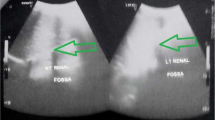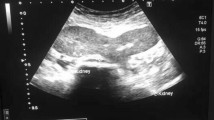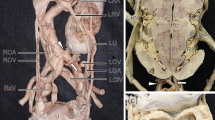Abstract
Renal ectopia and fusion anomalies are Congenital Anomalies of the Kidney and the Urinary Tract (CAKUT) that are usually incidentally detected and asymptomatic. Patients affected present a higher risk of complications like recurrent urinary tract infections or obstruction. Pancake kidney (PK) is one of the rarest types of renal anomaly with complete fusion of the superior, mild and inferior poles of both kidneys in the pelvic cavity. Each kidney has its own excretory system with two ureters that do not cross the midline. In the asymptomatic cases, a conservative approach should be performed. Surgical management may be needed when urological problems occur. PK is often associated with congenital anomalies of other organs. Ultrasound is the first line radiological examination for the diagnosis and the follow-up of kidney malformations. The main sonographic findings suggesting PK diagnosis are a large and lobulated renal mass consisting of two fused lateral lobes without an intervening septum located in the pelvic cavity. Each lobe usually has a separate pelvicalyceal system, the renal pelvis is anteriorly placed and the ureters are usually short and enter the bladder normally without crosses the midline. Ultrasonography gives useful information on the morphology and volume of the organ, and on its vascularization through the use of the Color- and Power-Doppler. Computer Tomography and Magnetic Resonance Urography are second level techniques used to confirm the diagnosis and to evaluate the presence of other abnormalities. The knowledge of the imaging findings and the anatomy of congenital renal malformations is important to avoid diagnostic pitfalls and misinterpretations. We report the case of a 14-years old female with PK who was misdiagnosed with a horseshoe kidney (HSK) during an abdominal ultrasound.
SOMMARIO
L’ectopia e le anomalie di fusione renale rientrano nel gruppo delle Anomalie Congenite del Rene e del Tratto Urinario (CAKUT, Congenital Anomalies of the Kidney and Urinary Tract). Generalmente asintomatiche, queste condizioni vengono descritte come reperti incidentali. I pazienti affetti presentano un rischio più elevato di complicanze dell’apparato urinario, come infezioni e/o ostruzioni. Il rene a focaccia è una rara malformazione congenita dell’apparato urinario caratterizzata dalla fusione dei poli superiori, medi ed inferiori di entrambi i reni all’interno della cavità pelvica. Ogni rene è dotato di un proprio sistema escretore, i cui corrispettivi ureteri non attraversano la linea mediana. Nei casi asintomatici il trattamento è di tipo conservativo; il trattamento chirurgico è indicato solo in caso di complicanze urologiche. Il rene a focaccia può associarsi spesso a malformazioni congenite di altri organi o apparati. L’ecografia è la metodica di imaging di prima istanza utile sia per la diagnosi che per il follow-up delle anomalie renali congenite. I principali segni ecografici che suggeriscono la diagnosi di PK sono una voluminosa e lobulata massa renale in sede pelvica, formata dalla fusione dei due reni in assenza di setti. Ogni reni presenta un sistema calico-pielico autonomo e separato, i cui ureteri non oltrepassano la linea mediana e dopo un breve decorso sboccano normalmente in vescica. L’ecografia fornisce, pertanto, informazioni morfologiche e volumetriche, ma anche sulla vascolarizzazione mediante l’utilizzo del Color- e Power-doppler. Metodiche di imaging di secondo livello sono la Tomografia Computerizzata e la Uro-Risonanza Magnetica, utili per un ulteriore conferma diagnostica e per identificare eventuali altre anomalie. La conoscenza delle singole caratteristiche delle varie malformazioni renali è importante per evitare i frequenti errori diagnostici. In questo articolo descriviamo il caso di una paziente di sesso femminile di 14 anni con rene a focaccia, erroneamente diagnosticato come rene a ferro di cavallo in una precedente ecografia dell’addome.



Similar content being viewed by others
References
Ramanathan S, Kumar D, Khanna M, Al Heidous M, Sheikh A, Virmani V, Palaniappan Y (2016) Multi-modality imaging review of congenital abnormalities of kidney and upper urinary tract. World J Radiol. https://doi.org/10.4329/wjr.v8.i2.132
Ghawanmeh HM, Al-Ghazo M, Halalsheh OM, Al-Ghazo OM, Alshammari AK, Al-Karasneh AI, Al-Okour R (2017) Pancake kidney found inside abdominal cavity: rare case with literature review. Urol Case Rep 13:123–125. https://doi.org/10.1016/j.eucr.2016.11.020
Wong HYF, Lee KH (2018) The pancake kidney. Abdom Radiol. https://doi.org/10.1007/s00261-018-1706-x
Prasad DVSR, Srinivas S (2016) Problem of fused kidneys—our observations. IAIM 3(9):182–188
Tublin ME, Bude RO, Platt JF (2003) The resistive index in renal Doppler sonography: where do we stand. Am J Roentgenol. https://doi.org/10.2214/ajr.180.4.1800885
Srinivas MR, Adarsh KM, Jeeson R, Ashwini C, Nagaraj BR (2016) Congenital anatomic variants of the kidney and ureter: a pictorial essay. Jpn J Radiol. https://doi.org/10.1007/s11604-015-0514-2
Babu CSR, Sharma V, Gupta OP (2015) Renal fusion anomalies: a review of surgical anatomy. Anat Physiol. https://doi.org/10.4172/2161-0940.s5-001
Oktem H, Gozil R, Calguner E, Bahcelioglu M, Mutlu S, Kurkcuoglu A, Kadioglu D (2008) Morphometric study of a horseshoe kidney. Med Princ Pract 17(1):80–83. https://doi.org/10.1159/000109596
Schiappacasse G, Aguirre J, Soffia P, Silva CS, Zilleruelo N (2015) CT findings of the main pathological conditions associated with horseshoe kidneys. Br J Radiol 88(1045):20140456. https://doi.org/10.1259/bjr.20140456
Pupca G, Miclăuş GD, Bucuraş V, Iacob N, Sas I, Matusz P, Loukas M (2014) Left crossed fused renal ectopia L-shaped kidney type, with double nutcracker syndrome (anterior and posterior). Romanian J Morphol Embryol 55:1237–1241
Bhatnagar V, Gupta A, Kumar R, Solanki S (2013) Crossed fused renal ectopia: challenges in diagnosis and management. J Indian Assoc Pediatr Surg 18(1):7. https://doi.org/10.4103/0971-9261.107006
Mudoni A, Caccetta F, Caroppo M, Musio F, Accogli A, Zacheo MD, Nuzzo V (2017) Crossed fused renal ectopia: case report and review of the literature. J Ultrasound 20(4):333–337. https://doi.org/10.1007/s40477-017-0245-6
Tiwari AK, Choudhary AK, Khowal H, Chaudhary P, Arora MP (2014) Pancake kidney: a rare developmental anomaly. J Can Urol Assoc 8:7–8. https://doi.org/10.5489/cuaj.1933
Looney WW, Dodd DL (1926) An ectopic (pelvic) completely fused (cake) kidney associated with various anomalies of the abdominal viscera. Ann Surg 84:522–524
Hollis HW, Rutherford RB, Crawford GJ, Cleland BP, Marx WH, Clark JR (1989) Abdominal aortic aneurysm repair in patients with pelvic kidney: technical considerations and literature review. J Vasc Surg 9(3):404–409. https://doi.org/10.1016/S0741-5214(89)70001-X
Pasquali M, Sciascia N, Liviano GDA, La Manna G, Zompatori M (2018) Case report pancake kidney: when it is not a problem. BJR Case Rep 4:3–6
Rosenthal AA, Ditchek JJ, Lee SK, Sanchez R, Kiffin C, Davare DL, Carrillo EH (2016) Congenital renal fusion and ectopia in the trauma patient. Case Rep Emerg Med 2016:1–4. https://doi.org/10.1155/2016/5203872
Sado HN, Duarte PS, Sapienza MT (2016) Pancake kidney with cysts and a single ureter Dear. Bcad. Radiol Brasil 49(2):127–128
Walther A, Cost NG, Garrison AP, Geller JI, Alam S, Tiao GM (2013) Renal rhabdomyosarcoma in a pancake kidney. Urology 82(2):458–460. https://doi.org/10.1016/j.urology.2013.03.003
Grenier N, Gennisson JL, Cornelis F, Le Bras Y, Couzi L (2013) Renal ultrasound elastography. Diagnostic and Interventional Imaging 94(5):545–550. https://doi.org/10.1016/j.diii.2013.02.003
Putz FJ, Erlmeier A, Wiesinger I, Verloh N, Stroszczynski C, Banas B, Jung EM (2017) Contrast-enhanced ultrasound (CEUS) in renal imaging at an interdisciplinary ultrasound centre: possibilities of dynamic microvascularisation and perfusion. Clin Hemorheol Microcirc 66(4):293–302. https://doi.org/10.3233/CH-179103
Nahm A, Ritz E (1999) Horseshoe kidney. Nephrol Dial Transplant 14:2740–2741. https://doi.org/10.1093/ndt/14.11.2740
Chen CY, Hsu JS, Jaw TS, Shih MCP, Lee LJ, Tsai TH, Liu GC (2015) Split-bolus portal venous phase dual-energy CT urography: protocol design, image quality, and dose reduction. Am J Roentgenol 15:25–26. https://doi.org/10.2214/ajr.14.13687
Napolitano M, Damasio MB, Grumieri G (2012) Ruolo dell’ uro-risonanza magnetica in urologia pediatrica : stato dell’ arte 42:163–169
Leyendecker JR, Barnes CE, Zagoria RJ (2008) MR urography: techniques and clinical applications. RadioGraphics 28(1):23–46. https://doi.org/10.1148/rg.281075077
Author information
Authors and Affiliations
Corresponding author
Ethics declarations
Conflict of interest
The authors declare that they have no conflict of interest.
Ethical approval
All procedures performed in studies involving human participants were in accordance with the ethical standards of the institutional and/or national research committee and with the 1964 Helsinki declaration and its later amendments or comparable ethical standards.
Human and animal rights
This article does not contain any studies with animals performed by any of the authors.
Informed consent
Informed consent was obtained from all individual participants included in the study.
Rights and permissions
About this article
Cite this article
Lomoro, P., Simonetti, I., Vinci, G. et al. Pancake kidney, a rare and often misdiagnosed malformation: a case report and radiological differential diagnosis. J Ultrasound 22, 207–213 (2019). https://doi.org/10.1007/s40477-018-0331-4
Received:
Accepted:
Published:
Issue Date:
DOI: https://doi.org/10.1007/s40477-018-0331-4




